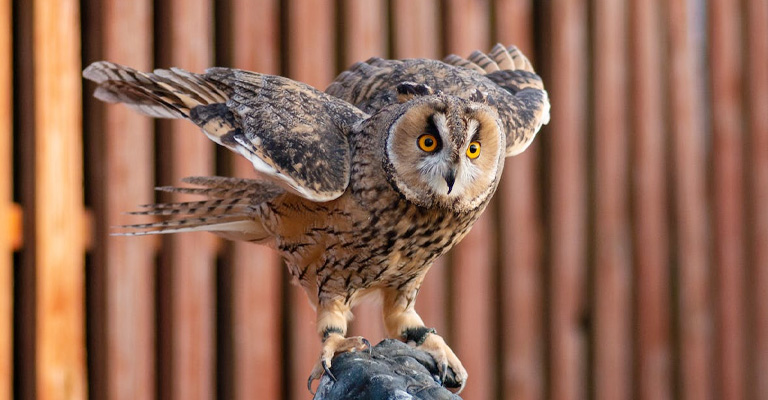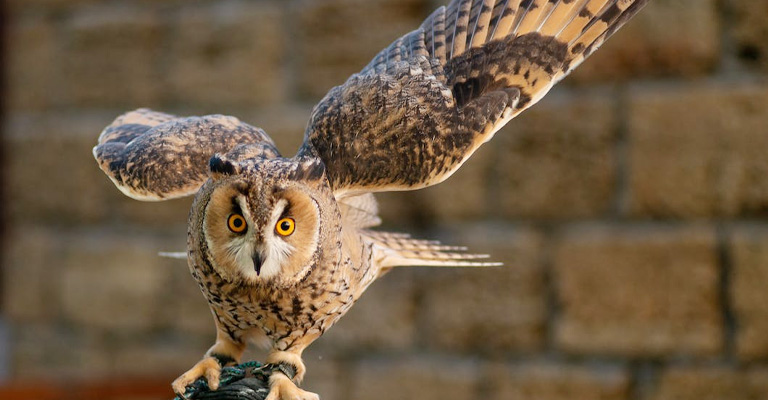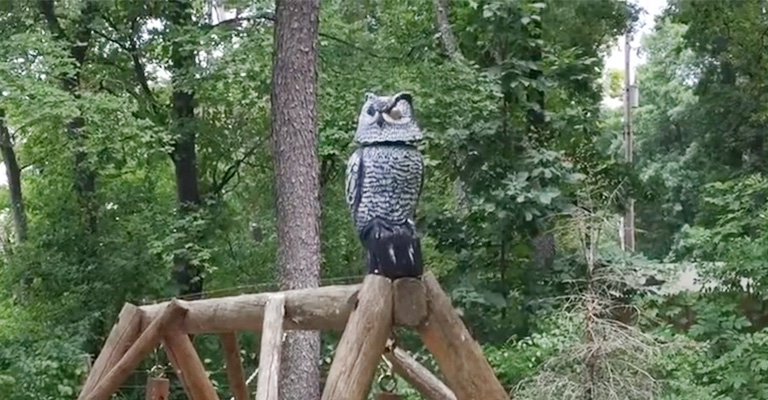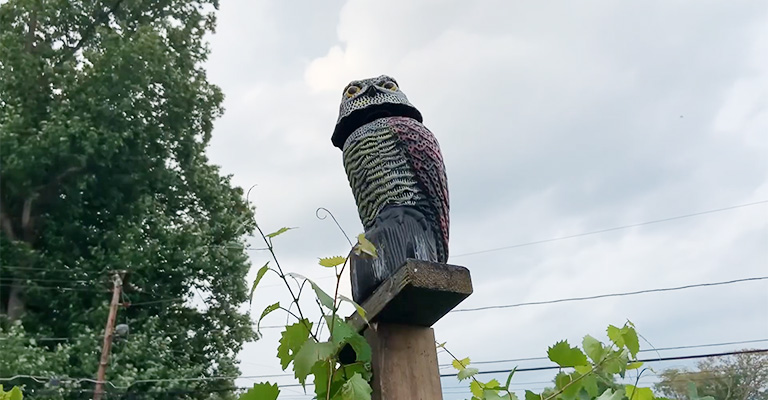Birds, known for their grace and agility in the skies, exhibit fascinating behaviors when it comes to their interactions with other avian species. One intriguing phenomenon is their fear and apprehension toward owls.
Despite being fellow birds, many species display a distinct unease and wariness in the presence of these nocturnal predators. But why are birds scared of owls? Why do birds perceive owls as a threat, even during daylight hours when owls are less active?
In this article, we delve into the reasons behind birds’ fear of owls. We explore the various factors that contribute to this avian apprehension, including the owls’ physical characteristics, hunting prowess, and predatory reputation.
Join us as we unravel the intricate dynamics between birds and owls, shedding light on this captivating aspect of avian behavior.

Why Are Birds Scared of Owls?
Birds are often scared of owls due to several reasons. Let’s explore some of these reasons in detail:
Predatory Nature
Owls are natural predators, and many bird species have evolved to recognize them as a threat. Owls have sharp talons and a strong beak, which they use to catch and kill their prey.
Birds instinctively perceive owls as potential predators and react with fear to protect themselves.
Nocturnal Habits
Owls are primarily nocturnal creatures, meaning they are most active during the night. Birds, on the other hand, are diurnal, meaning they are active during the day.
The sudden appearance of an owl during daylight hours can startle and frighten birds, as it is outside their normal expectation.
Silent Flight
Owls possess specialized feathers that allow them to fly silently. This stealthy flight enables them to approach their prey without making any noise.
Birds, being highly sensitive to sound, may not detect the presence of an owl until it is too late. This element of surprise can trigger fear and panic among birds.
Camouflage
Many owl species have excellent camouflage abilities, blending seamlessly with their surroundings. Their feathers often match the colors and patterns of tree bark or foliage, making them difficult to spot.
When birds fail to detect an owl nearby, it can lead to a sudden encounter, causing them to feel threatened and scared.
Mimicry
Some owl species possess the ability to mimic the calls of other birds. By imitating the sounds made by their prey or potential threats, owls can lure birds closer, making them vulnerable to attack.
This deceptive behavior can create a sense of fear and unease among birds, as they become wary of any unfamiliar calls.
Size and Appearance
Owls are generally larger than most bird species, and their appearance can be intimidating. Their large eyes, sharp beaks, and hooked talons give them a formidable appearance.
Birds may perceive owls as a direct threat due to their size and physical attributes, leading to fear and avoidance.
Previous Negative Experiences
Birds can learn from past encounters and develop a fear response towards predators. If a bird has had a negative experience with an owl, such as witnessing an attack or losing a fellow bird to an owl, it can imprint a lasting fear in their memory.
This learned fear can be passed down through generations, leading to a general aversion to owls.
Nest Predation
Owls are known to prey on bird nests, especially during the breeding season. They can silently approach nests and snatch eggs or nestlings, causing significant harm to bird populations. The fear of losing their offspring to an owl’s attack can make birds highly vigilant and fearful of their presence.
What Do Birds Hate the Most?

Birds have different preferences and aversions, but there are a few things that many birds tend to dislike. Here are some common things that birds may dislike:
Loud Noises
Birds have sensitive hearing, and loud noises can startle and disturb them. Fireworks, loud music, or construction noises can cause stress and discomfort for birds. It’s best to avoid creating excessive noise near bird habitats or nesting areas.
Predators
Birds naturally fear predators that pose a threat to them. This includes animals like cats, snakes, and larger birds of prey. The presence of these predators can cause birds to feel unsafe and may drive them away from an area.
Bright Lights
Birds are diurnal creatures and are adapted to natural light cycles. Artificial lights, especially bright and flashing lights, can disorient and confuse birds. Light pollution can interfere with their navigation and disrupt their natural behavior.
Sudden Movements
Birds are highly alert to movement, as it can indicate the presence of a predator. Quick and sudden movements can startle birds and cause them to fly away or become agitated. It’s best to approach birds calmly and avoid making sudden gestures or movements.
Unfamiliar Objects
Birds can be wary of unfamiliar objects in their environment. Large structures, like wind turbines or tall buildings, can disrupt their flight patterns and cause them to avoid certain areas.
Similarly, objects like scarecrows or reflective surfaces may deter birds from approaching gardens or crops.
Strong Odors
Birds have a keen sense of smell, and certain strong odors can be unpleasant or even harmful to them. Chemicals, pesticides, or strong fragrances can repel birds and may have negative effects on their health.
It’s important to use bird-friendly and environmentally safe products in areas where birds are present.
Harsh Weather Conditions
Extreme weather conditions, such as heavy rain, strong winds, or intense heat, can be challenging for birds.
They may seek shelter or change their behavior to cope with these conditions. Providing birdhouses, bird baths, or natural shelters can help birds find refuge during harsh weather.
Will Artificial Owls Keep Birds Away?

Artificial owls can be used as a deterrent to keep some birds away, but their effectiveness may vary depending on the bird species and the specific circumstances. Here are some points to consider:
Visual Deterrent
Artificial owls are often designed to resemble real owls, with lifelike features and colors. The idea is to create the illusion of a predator and scare away smaller birds. Some bird species may be initially startled by the presence of an artificial owl and choose to avoid the area.
Species-Specific Response
The effectiveness of artificial owls as bird deterrents can depend on the bird species in question.
While some birds may be frightened by the sight of an owl, others may quickly recognize it as a non-threatening object.
Additionally, birds that are familiar with their natural predators, such as crows or hawks, may not be deterred by an artificial owl.
Habituation
Birds can become habituated to static objects over time. If an artificial owl remains in the same location for an extended period, birds may eventually realize that it poses no actual threat.
To maintain its effectiveness, it may be necessary to periodically move or reposition the artificial owl.
Combination with Other Methods
Using artificial owls as part of a comprehensive bird control strategy can enhance their effectiveness.
For example, combining them with reflective materials, noise deterrents, or physical barriers can create a more dynamic and unpredictable environment for birds, making it less appealing for them to stay.
Limitations
Artificial owls may not be effective against all bird species. Some birds, such as pigeons or sparrows, are highly adaptable and may not be deterred by visual cues alone. In such cases, additional measures like netting, spikes, or repellents may be necessary to effectively manage bird populations.
Improving the Effectiveness of Decoy Owls

To improve the effectiveness of decoy owls as bird deterrents, consider the following strategies:
Movement
Birds are more likely to be deterred by a decoy owl that appears to be active rather than stationary. Adding movement to the decoy can make it more convincing and increase its effectiveness.
You can achieve movement by attaching a rotating mechanism or using wind-powered devices to make the decoy’s head or wings move.
Realistic Appearance
Ensure that the decoy owl closely resembles a real owl in terms of size, shape, and coloration. Birds are more likely to be deterred if the decoy looks authentic. Consider using high-quality decoys made from materials that mimic the texture and appearance of real feathers.
Placement
Position the decoy owl strategically in areas where birds are causing problems or where you want to deter them.
Place it in a prominent location, such as near bird feeders, gardens, or areas where birds tend to roost or nest. Regularly change the decoy’s location to prevent birds from becoming habituated to its presence.
Predator Calls
Some decoy owls come equipped with speakers that emit owl calls or distress calls from other birds.
These sounds can enhance the deterrent effect by creating a more realistic and threatening environment. Rotate the types of calls used to prevent birds from becoming accustomed to a specific sound.
Combination with Other Deterrents
Enhance the effectiveness of decoy owls by combining them with other bird deterrent methods.
For example, use reflective materials, such as shiny tape or scare balloons, to create additional visual deterrents.
Employ noise deterrents, such as wind chimes or predator calls, to create an auditory deterrent. Combining multiple deterrents can make the environment less appealing and more unpredictable for birds.
Regular Maintenance
Keep the decoy owl clean and in good condition. Dust, dirt, or weathering can make the decoy less convincing and reduce its effectiveness. Regularly inspect the decoy for any damage or wear and replace it if necessary.
Monitoring and Adaptation
Observe bird behavior and adjust your deterrent strategies accordingly. If birds are not being deterred by the decoy owl, consider trying different locations, movements, or additional deterrent methods.
Flexibility and adaptation are key to finding the most effective combination of deterrents for your specific bird control needs.
Remember that while decoy owls can be effective, they may not work for all bird species or in all situations. Understanding the behavior and preferences of the birds you are trying to deter will help you tailor your approach for better results.
FAQs
Decoy owls are not equally effective against all bird species. Some birds, especially those that are highly adaptable or have become habituated to human presence, may not be deterred by decoy owls alone.
The effectiveness of decoy owls can diminish over time as birds may become habituated to their presence. To maintain their effectiveness, it is recommended to periodically move or reposition the decoy owls.
Decoy owls can be used indoors in certain situations, such as warehouses or large enclosed spaces where birds may be causing problems. However, it’s important to ensure that the decoy owl is positioned in a way that appears natural and does not pose any safety hazards.
Decoy owls themselves do not harm birds. They are designed to visually mimic owls and create a deterrent effect. However, it’s important to ensure that the materials used in the decoy owl are safe for birds and do not pose any risks.
Decoy owls can be used in residential areas to deter birds, especially if there are specific bird-related issues such as nesting or roosting problems. However, it’s important to check local regulations and restrictions regarding the use of decoy owls or any other bird control methods.
Bottom Line
The fear that birds exhibit towards owls is a fascinating aspect of their behavior. Through their keen perception and evolutionary adaptations, birds have learned to recognize owls as potential threats, even during daylight hours.
The owls’ physical characteristics, hunting abilities, and predatory reputation all contribute to this fear response.
Understanding the dynamics between birds and owls not only provides insights into avian behavior but also highlights the intricate web of predator-prey relationships in the natural world.
By studying these interactions, we gain a deeper appreciation for the strategies and adaptations that birds employ to ensure their survival.
So, the next time you spot a bird taking flight at the sight of an owl, remember the complex interplay of instincts and survival mechanisms.